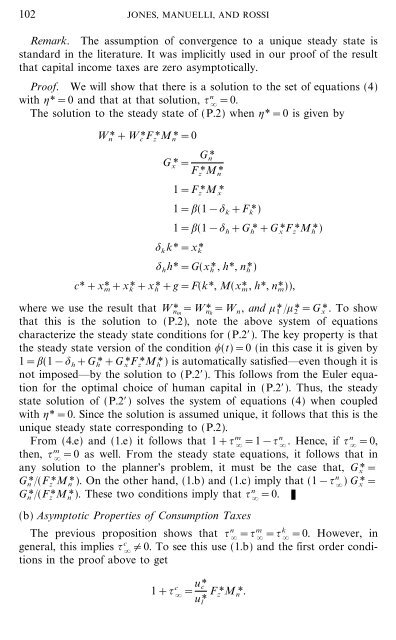On the Optimal Taxation of Capital Income
On the Optimal Taxation of Capital Income
On the Optimal Taxation of Capital Income
Create successful ePaper yourself
Turn your PDF publications into a flip-book with our unique Google optimized e-Paper software.
102 JONES, MANUELLI, AND ROSSI<br />
Remark. The assumption <strong>of</strong> convergence to a unique steady state is<br />
standard in <strong>the</strong> literature. It was implicitly used in our pro<strong>of</strong> <strong>of</strong> <strong>the</strong> result<br />
that capital income taxes are zero asymptotically.<br />
Pro<strong>of</strong>. We will show that <strong>the</strong>re is a solution to <strong>the</strong> set <strong>of</strong> equations (4)<br />
with '*=0 and that at that solution, { n =0.<br />
The solution to <strong>the</strong> steady state <strong>of</strong> (P.2) when '*=0 is given by<br />
W n*+W c*F z*M n*=0<br />
Gx*= Gn* Fz*Mn* 1=Fz*Mx* 1=;(1&$ k+Fk*) 1=;(1&$ h+Gh*+Gx*F z*Mh*) $ kk*=xk* $ hh*=G(xh*, h*, nh*) c*+x* m+xk*+xh*+g=F(k*, M(x* m, h*, n* m)),<br />
where we use <strong>the</strong> result that W* nm =W* nh =W n, and + 1* + 2*=G x*. To show<br />
that this is <strong>the</strong> solution to (P.2), note <strong>the</strong> above system <strong>of</strong> equations<br />
characterize <strong>the</strong> steady state conditions for (P.2$). The key property is that<br />
<strong>the</strong> steady state version <strong>of</strong> <strong>the</strong> condition ,(t)=0 (in this case it is given by<br />
1=;(1&$ h+G h*+G x*F z*M h*) is automatically satisfied even though it is<br />
not imposed by <strong>the</strong> solution to (P.2$). This follows from <strong>the</strong> Euler equation<br />
for <strong>the</strong> optimal choice <strong>of</strong> human capital in (P.2$). Thus, <strong>the</strong> steady<br />
state solution <strong>of</strong> (P.2$) solves <strong>the</strong> system <strong>of</strong> equations (4) when coupled<br />
with '*=0. Since <strong>the</strong> solution is assumed unique, it follows that this is <strong>the</strong><br />
unique steady state corresponding to (P.2).<br />
From (4.e) and (1.e) it follows that 1+{ m =1&{ n . Hence, if { n =0,<br />
<strong>the</strong>n, { m =0 as well. From <strong>the</strong> steady state equations, it follows that in<br />
any solution to <strong>the</strong> planner's problem, it must be <strong>the</strong> case that, G x*=<br />
G n* (F z*M n*). <strong>On</strong> <strong>the</strong> o<strong>the</strong>r hand, (1.b) and (1.c) imply that (1&{ n ) G x*=<br />
G n* (F z*M n*). These two conditions imply that { n =0. K<br />
(b) Asymptotic Properties <strong>of</strong> Consumption Taxes<br />
The previous proposition shows that { n ={ m ={ k =0. However, in<br />
general, this implies { c {0. To see this use (1.b) and <strong>the</strong> first order conditions<br />
in <strong>the</strong> pro<strong>of</strong> above to get<br />
1+{ c = u c*<br />
u l* F z*M n*.
















